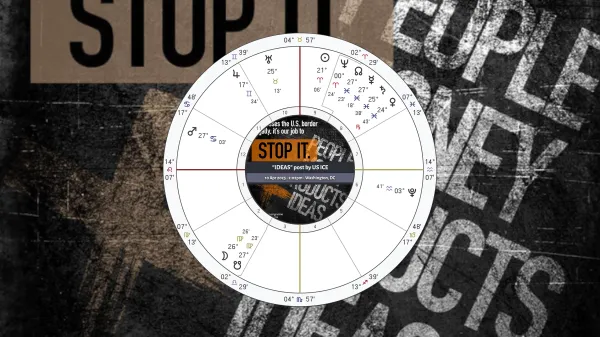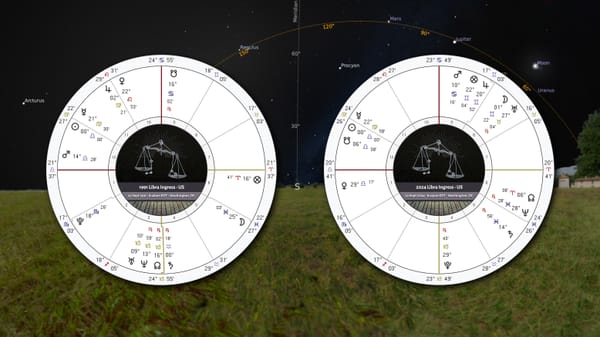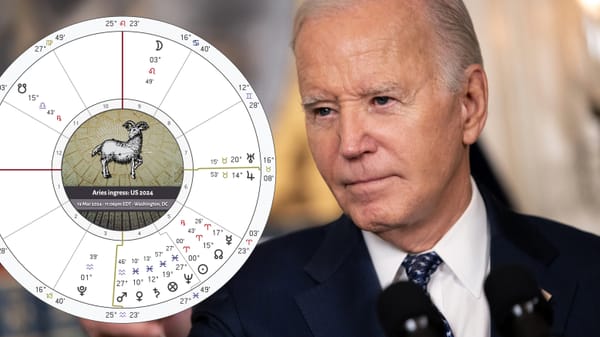Example horary & a mandala of relationship
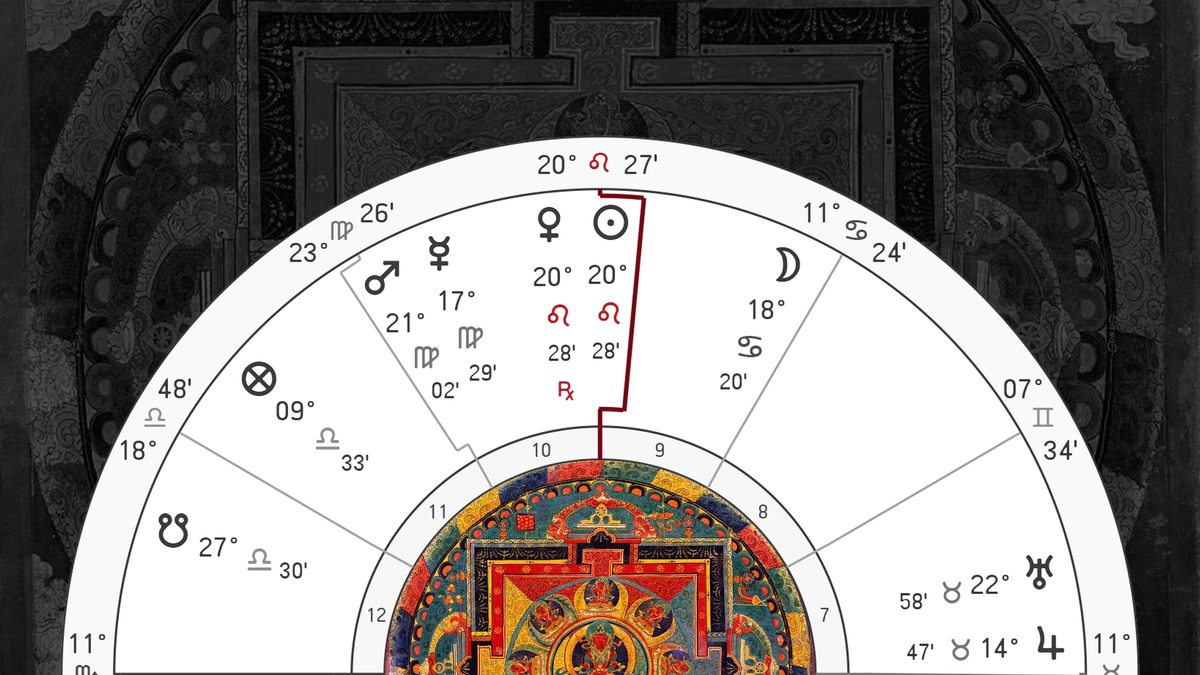
Three nights ago, I had a dream – what would it look like, and what would it mean, to find all of the planetary pairings coming together, building toward a sense of unity and connection no matter what sign ascended?
A configuration like the one from my dream was at the center of my first horary consultation of the day. (Notes on that horary can be found in the back half of this email.)
A mandala of relationship
A rare and fascinating pattern is being drawn against the backdrop of our skies at this present moment, with each of the seven traditional planets in direct application to the planet ruling the opposing sign.
When using the first and seventh house axis to assess the strength and quality of interpersonal relationships, there are only four combinations that can be drawn:
- The Sun (ruler of Leo) pairs with Saturn (ruler of Aquarius)
- The Moon (ruler of Cancer) pairs with Saturn (ruler of Capricorn)
- Mercury (ruler of Gemini and Virgo) pairs with Jupiter (ruler of Sagittarius and Pisces)
- Venus (ruler of Taurus and Libra) pairs with Mars (ruler of Scorpio and Aries)
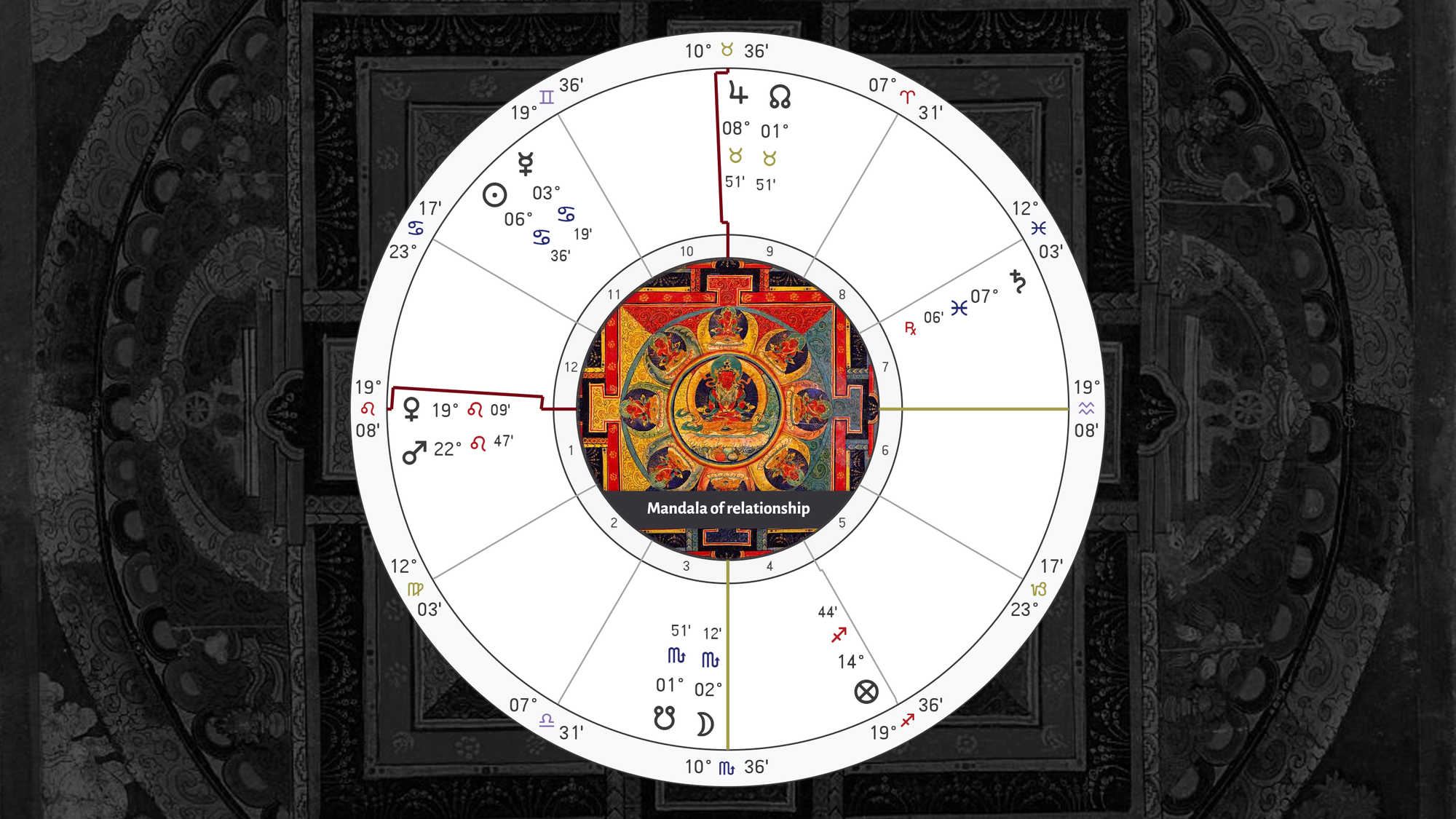
Above, today's astrology.
Note that the Sun and Moon, which rule the signs opposite to Saturn, both apply to Saturn by trine aspect. Saturn is retrograde, so we can say that Saturn is similarly striving to meet the two luminaries in their courses. Mercury applies to Jupiter by sextile, with reception. Venus applies to Mars by conjunction. The Moon applies to the Sun by trine, uniting the two luminaries.
All pairs are coming together!
And these pairings are signified by planets in an array of astrological conditions. Saturn's retrograde, so a retrograde signature will feature in at least two of the relationships described (Sun/Saturn, Moon/Saturn). The Moon is in its sign of fall, conjunct the South Node, bringing quite a bit to unpack to the Moon/Saturn relationship. The Sun applies to Saturn from Saturn's sign of detriment, which kicks up themes of disapproval that need smoothing. Mercury applies to Jupiter from Jupiter's sign of exaltation, showing a willing and active spirit of generosity exchanged between those two.
The ups and downs of everyday couples are distributed across this map, showing people coming together from, and in, all conditions.
We might stretch this mandala's reach a bit further to consider how the three exaltation pairs are also connected to one another.
The Babylonians called the signs of exaltation the planet's 'sacred place', where the mysteries of that planet are revealed.
The Sun is exalted in Aries, and Saturn in Libra – the two are in a mutually applying trine. Jupiter's 'sacred place' is in Cancer, opposite to Capricorn where Mars is exalted. The two are a bit wide to be considered in applying trine, but the Moon separates from Mars and applies to Jupiter and so connects them via translation of light. Mercury is exalted in Virgo, Venus in Pisces, and these two are also connected via the translation of the Moon.
Across all dignity avenues, what is being shown is an intricate pattern, or mandala, of relationships – romantic or otherwise – coming together in a way that facilitates union, agreement and (in some cases) repair.
But what about the movement of Venus – she is slowing as she approaches the retrograde station and won't complete her conjunction to Mars. What do we make of that?
But what about Venus? Isn't Venus about to turn Rx?
Yes, it's true – Venus and Mars are the one pair obstructed in their union. Venus never completes its conjunction to Mars, turning retrograde far before she can catch up to Mars (who will have slipped onto the next sign of Virgo in the meantime).
Some may think this breaks the configuration of all planetary pairings coming together – but even this moment of refranation is a yield to deeper magic, magic invoking one of the oldest images of union and reconnection known to our art.
Mars was not Venus's first celestial mate.
That honor belongs to the undying Sun, and it is Venus's everlasting relationship to the Sun that compels her stations retrograde and direct.
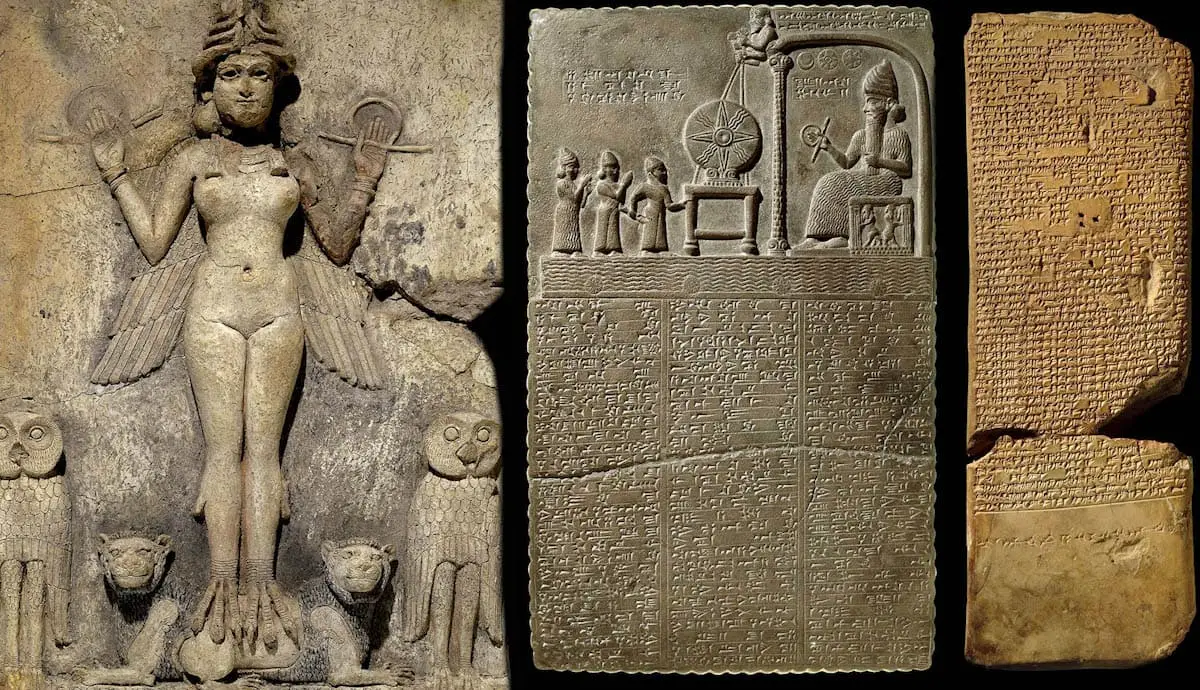
The synodic cycles of Venus (i.e., Venus's position in relation to the Sun) were of great importance to early astrologers, and echoes of this Babylonian scheme reverberate in Persian/Arabic, medieval and Renaissance texts.
I would refer anyone interested in this lore to look out for Deborah Houlding's forthcoming title on this theme, The Ring and the Heart.
The rhythm and dance between the Sun and Venus measure cycles of fertility and relationship, showing growth and connection or stagnation and discord. When Venus applies to the Sun, the beloved chases after the lover. At conjunction, they are united. When Venus separates or pulls away from the Sun, relationships on a mundane level begin to break down.
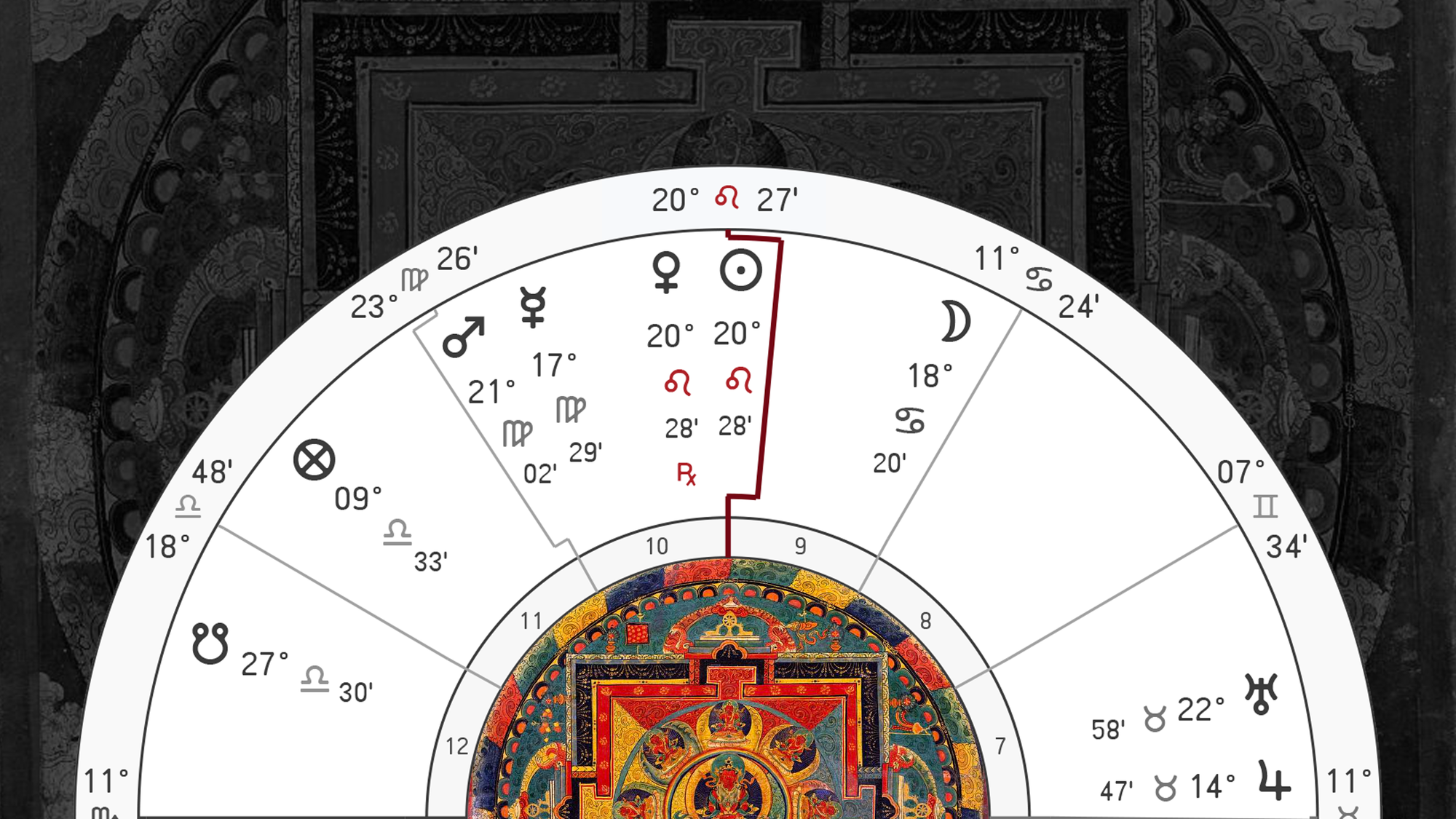
But there comes a point in Venus's wanderings where she begins to slow. At maximum elongation east (which is behind us now, having occurred on June 4) Venus's speed drops below the Sun's daily motion, and the Sun begins to close the distance between them. When Venus stations retrograde, the beloved turns back, to once again reunite with the great image of the lover.
No matter what way you cut it, the sky at this moment is reflecting a collective yearning for reconciliation, healing, connection, set against the backdrop of generative, life-giving themes.
A new favorite horary, answering tough questions through this relationship mandala
The querent is an academic and contemporary artist. She's got good standing as a teaching academic, and would be able to progress further down that track if she completed a PhD program.
The querent had been enrolled in a PhD program before, but dropped out after the traumatic and unexpected passing of her father. Should she go to grad school next year? If so, does astrology have anything to say about where she should pursue her degree – with an art school, or with the university where she currently teaches?
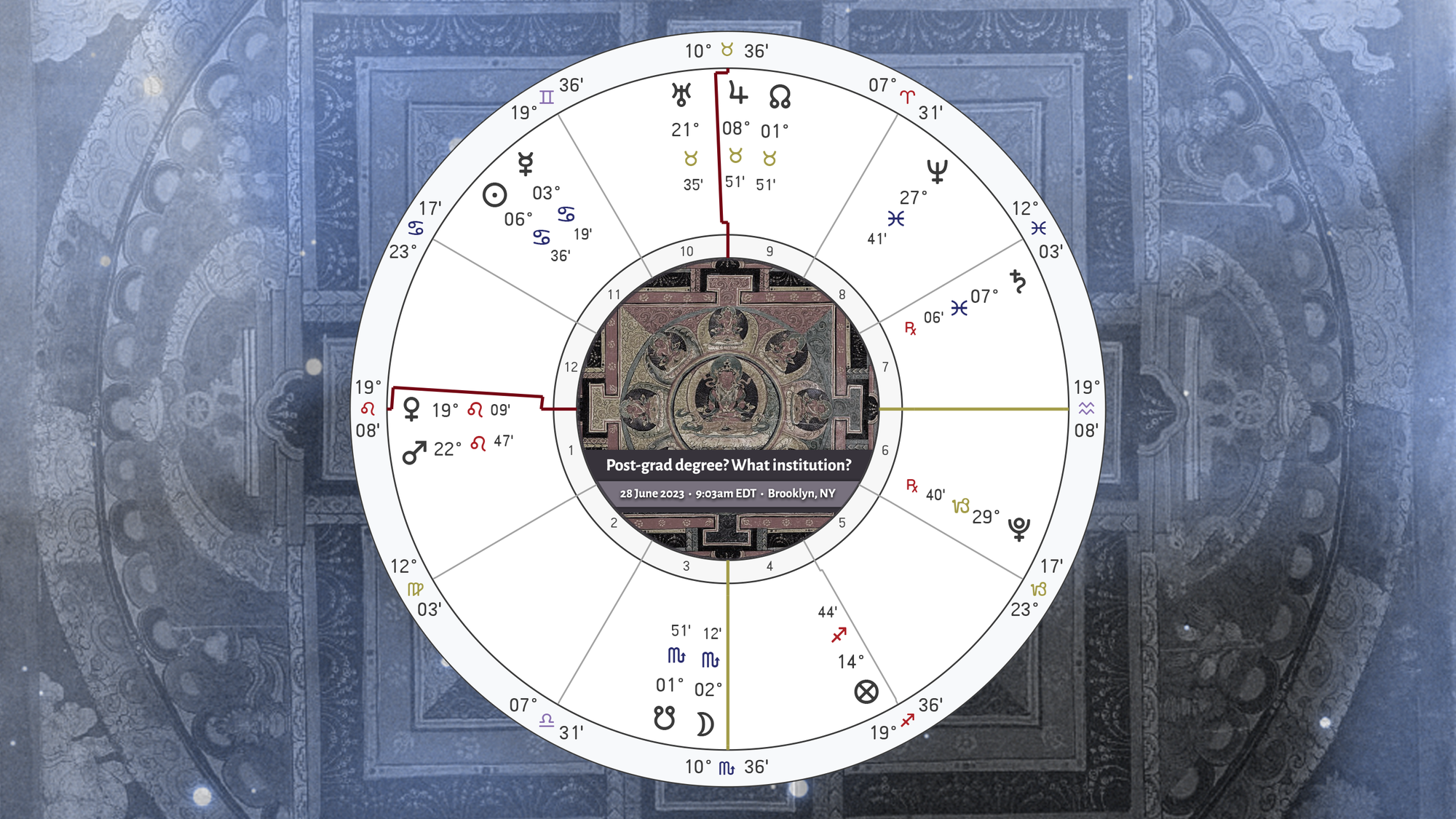
I'll cut right to the chase. This chart loudly supports her in continuing down her current professional path, and pursuing a doctoral program next year.
The Sun is in the 11th house, being applied to by 11th-ruler Mercury – this is quite a fortunate start, and provided there's no serious affliction shown to the ascendant, midheaven or Moon, it could be enough to indicate a successful outcome.
The 10th-ruler Venus is positioned on the ascendant, slow in motion (which perhaps points to some stalling she's experienced without holding a PhD), and Jupiter crowns the midheaven. With benefics on angles, there's almost a sense of the intended course of action being 'blessed'.
Mars, ruler of the 9th house, is positioned in the ascendant, which shows a smooth path to admission. Perhaps not perfectly smooth – Mars is Mars after all, and separating from a square to Uranus. But I did wonder whether the square to Uranus was pointing to the disruption of her previous study due to tragic events of a sudden and erratic nature.
There's a clear theme of meeting the grief of a bereaved father in this chart. As I said already, Mars rules the 4th house of fathers and is in the ascendant (i.e., time to take the deep things inward). The Sun, ruler of the 1st house, is perhaps the most obvious natural significator for fathers; but the Sun is in close aspect to Jupiter and Saturn, who might also represent father figures. The Sun and Moon both apply to Saturn on the cusp of the 8th, and Jupiter as 8th-ruler disposits both the Sun and Saturn from the 10th cusp. The 8th house of death, loss and bereavement is reinforced here from many angles.
The Sun's aspect to Saturn is powerful, but this is just a stopover on a slightly longer journey to sextile Jupiter on the midheaven, with reception. Passing through the wall of grief to invest in one's own future potential – that is the image being reflected here.
Should she enroll in art school (where she would pursue a PhD in contemporary art), or in the university where she teaches (where should would pursue a PhD in gender studies)?
I never guarantee I can answer a question like this, because I can't answer it the way a client might think. I have no idea how to read 'art school' from any other type of school astrologically – I believe all of the planets are artful in their own way, and the signs provide different media for artful planets. Pursuing this directly isn't going to help me, and there's no technique at my disposal which can reliably confirm 'art school'.
But I had some contextual help: the other option is where she currently teaches. And whether the astrology is favorable for pursuing a more familiar path is something I can do.
I looked for themes of familiarity and recognition, and they were everywhere in this chart. The Sun and Moon are in trine – when the luminaries are cooperating, they tend to point to things that are known, or reveal paths kept hidden. Being disposed by a planet underscores familiarity between those two. The Sun (the querent) was disposited by Jupiter (advancement) on the midheaven (where she currently works) – she should invest where she is. The Sun disposes of Mars (the 9th-ruler, or house of higher education), and Mars is in the ascendant – she is already in the environment she's seeking. Even Mercury, the eternal student of the heavens, is conjunct the ascendant-ruler and in the same sign.
The path is already all around her, she doesn't need to seek it out somewhere else.
But she followed up with an unexpected question.
Could astrology help guide her in choosing a dissertation topic?
Because I have no expertise in gender studies or contemporary art, I had to admit that any attempt to answer that would be me grasping in the dark. There's no more sense doing that with astrology than there is in an overstocked pantry.
She smiled, saying she understood, and said she had two theses in mind. I will paraphrase her responses. Her first idea:
"I wanted to look at the gender politics of two people's spaces. What is the theory behind the process of coupling? What is intimacy in a couple's settings? How are couples formed, what is the process of the joining, what intimacy is shared, what boundaries are broken, and how do gender politics inform this process?"
I don't think I needed to hear the second idea after listening to the querent discuss her vision for this first thesis. Right in front of us was a horary chart that doubled as a relationship mandala, where paired planets are coming together in an intricate dance made up of all sorts of awkward parts. Saturn being retrograde would have an impact on how private and joint spaces are formed in its relationships shown by its trines to the Sun and the Moon. Jupiter receiving Mercury has something to say on that theme, too. As would Saturn failing to receive the Sun's trine, or the Moon applying from her sign of fall. The thesis matches the astrology of the moment.
The second idea was a comparison between black box art spaces (abandoned warehouses, dark theaters, etc.), and white box art spaces (galleries, showrooms, etc.).
I could find this in signatures related to light. The Sun above the earth and the Moon below might point in that direction. The ascendant and midheaven both represent lit spaces, the 7th and 4th dark spaces. No clear emphasis emerged here.
Or, I could take an approach looking for themes of class and/or gentrification: battles between Saturn and Jupiter, packed 11th and 12th, themes of corrosion vs themes of refinement, etc. No clear emphasis here, either.
I couldn't see the box comparison theme as loudly articulated by the planets. But I did see some hints of it, and so I reminded my querent that, with her intuition, she could find a way to bring this black-box-vs-white-box motif into the relationship thesis, even if just to serve as a structural metaphor.
It was a powerful consultation, and more was discussed than is relevant for this newsletter. (For example: Saturn ruling the 6th, collecting the light of main significators, warns of taking too much on; the same with the Moon moving to oppose Jupiter on the midheaven.)
I found myself in a deeply grateful place this morning because of this mandala, and the conversation is inspired between my client and me.

